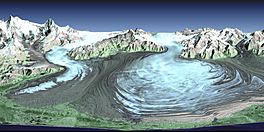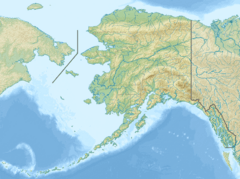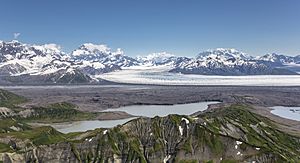Agassiz Glacier (Alaska) facts for kids
Quick facts for kids Agassiz Glacier |
|
|---|---|

Malaspina Glacier is a compound glacier, formed by the merger of several valley glaciers, the most prominent of which seen here are Agassiz Glacier (left) and Seward Glacier (right).
|
|
| Type | Valley glacier |
| Coordinates | 60°11′00″N 140°48′00″W / 60.18333°N 140.80000°W |
| Length | 25 km |
| Terminus | outwash plains |
| Status | retreating |
The Agassiz Glacier is a large river of ice found in the Saint Elias Mountains. It flows through southern Alaska in the United States and also touches a small part of Canada.
This impressive glacier is about 25 kilometers (15.5 miles) long. It gets its name from Louis Agassiz, a famous Swiss-American scientist who studied nature and glaciers. He lived from 1807 to 1873. The glacier was named after him in 1886 by William Libbey, who was part of a special trip organized by The New York Times newspaper.
Where is the Agassiz Glacier?
The Agassiz Glacier starts high up on the southern side of Mount Malaspina. This mountain is located just north of the border between Canada and the United States.
The glacier is fed by another glacier called the Newton Glacier. The Agassiz Glacier is about three kilometers (nearly 2 miles) wide. It first flows towards the southwest, then changes direction and flows towards the southeast.
As it moves, another glacier, the Libbey Glacier, joins it from the west. Eventually, the Agassiz Glacier combines with the much larger Malaspina Glacier. The Malaspina Glacier then spreads out and reaches the Gulf of Alaska, which is part of the Pacific Ocean.
What is a Valley Glacier?
The Agassiz Glacier is a type of glacier known as a valley glacier. A valley glacier is like a slow-moving river of ice. It forms in high mountains and flows down through valleys. These glaciers are often found in places where a lot of snow falls and stays frozen all year round.
Glaciers like Agassiz are important because they shape the land. As they move, they can carve out valleys and carry away rocks and soil.
Is the Agassiz Glacier Changing?
Like many glaciers around the world, the Agassiz Glacier is currently retreating. This means that its end, or terminus, is slowly melting back. Scientists study glaciers like Agassiz to understand how the Earth's climate is changing.



